October 18, 2025
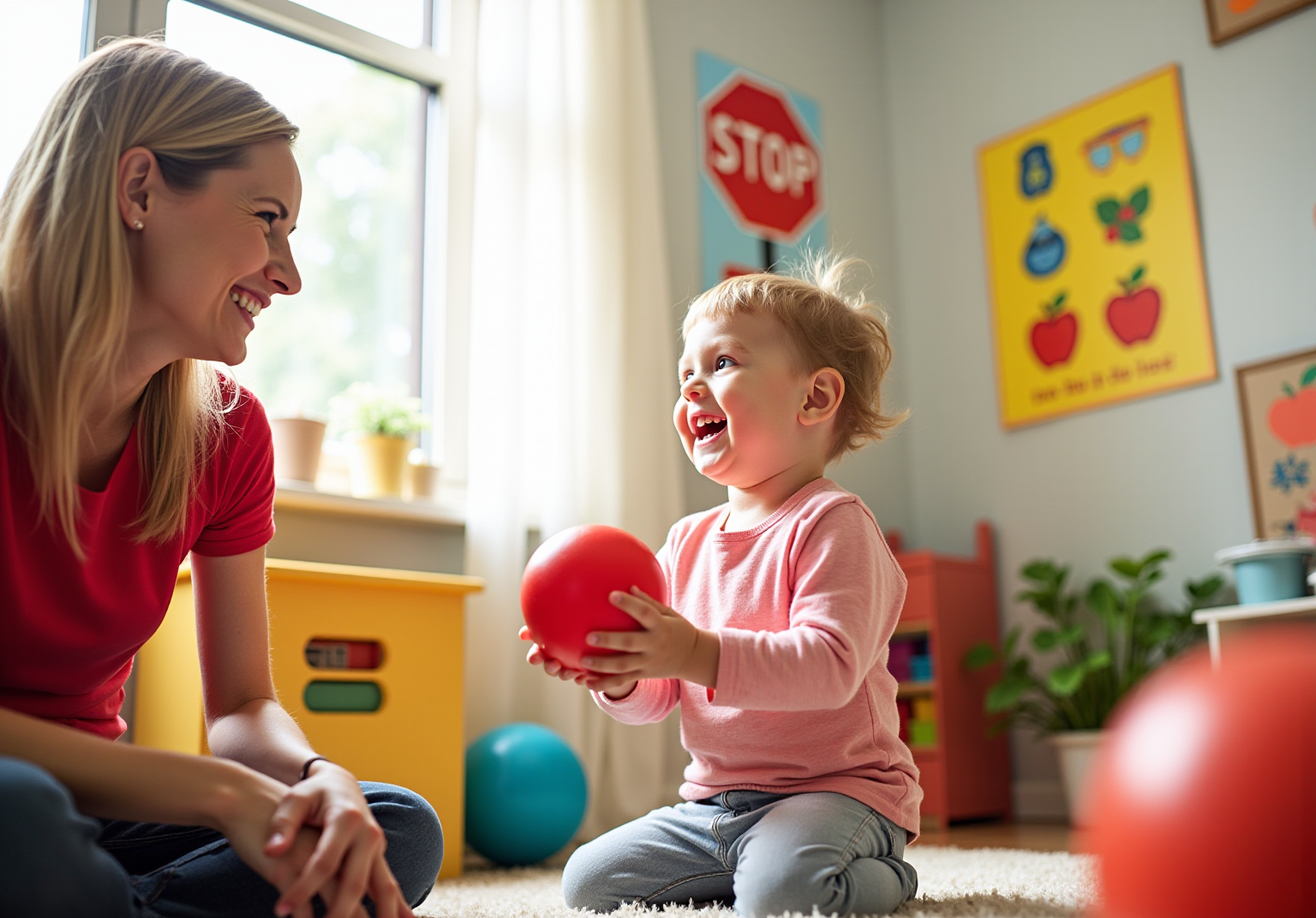
The article delves into the concept of stimulus generalization within Applied Behavior Analysis (ABA) therapy, a process where a learned response to a specific stimulus is elicited by similar stimuli. This concept is crucial in fostering adaptability and practical skills, particularly for individuals with autism. By demonstrating how learned behaviors can be applied across various real-life situations, the article underscores the significant impact on enhancing their quality of life.
Understanding how individuals learn and adapt is pivotal in the realm of Applied Behavior Analysis (ABA) therapy, particularly through the lens of stimulus generalization. This fascinating phenomenon enables learned responses to extend beyond specific cues, allowing individuals to navigate various social contexts with greater ease.
As practitioners strive to foster this adaptability, they face the challenge of ensuring that skills acquired in therapy translate effectively into everyday situations.
How can the principles of stimulus generalization be harnessed to enhance the quality of life for individuals with autism? What strategies can be employed to overcome the inherent obstacles in this process?
These questions are not just theoretical; they are essential for improving outcomes in ABA therapy.
This phenomenon involves the process by which a learned response to a specific cue is triggered by similar cues. In Applied Behavior Analysis (ABA), this concept is crucial; it allows individuals to apply learned behaviors across various contexts, thereby enhancing their adaptability and practical abilities. For instance, when a young person learns to say 'hello' to a known individual, they may also extend this greeting to unfamiliar people in similar situations, demonstrating stimulus transfer. This capability is vital for effective communication and social interaction, making it a primary focus in ABA therapy.
However, encouraging broad application can be challenging. It necessitates meticulous planning and execution of approaches that promote the use of abilities in diverse settings. Involving parents and caregivers in this process is essential, as their support reinforces the skills learned during therapy and helps children practice these skills in everyday situations. Moreover, understanding the ability to differentiate between comparable cues is crucial for effective categorization.
In ABA therapy, an example of stimulus generalization is one of the two primary types of generalization recognized, alongside response generalization. By endorsing these ideas, practitioners empower children with autism to utilize their abilities in practical situations, fostering autonomy and self-assurance in their daily lives. The significance of this concept is underscored by its role in ensuring that skills acquired during therapy are not confined to clinical settings. Instead, they are applied in various environments, such as home and school, ultimately enhancing the quality of life for individuals with autism.
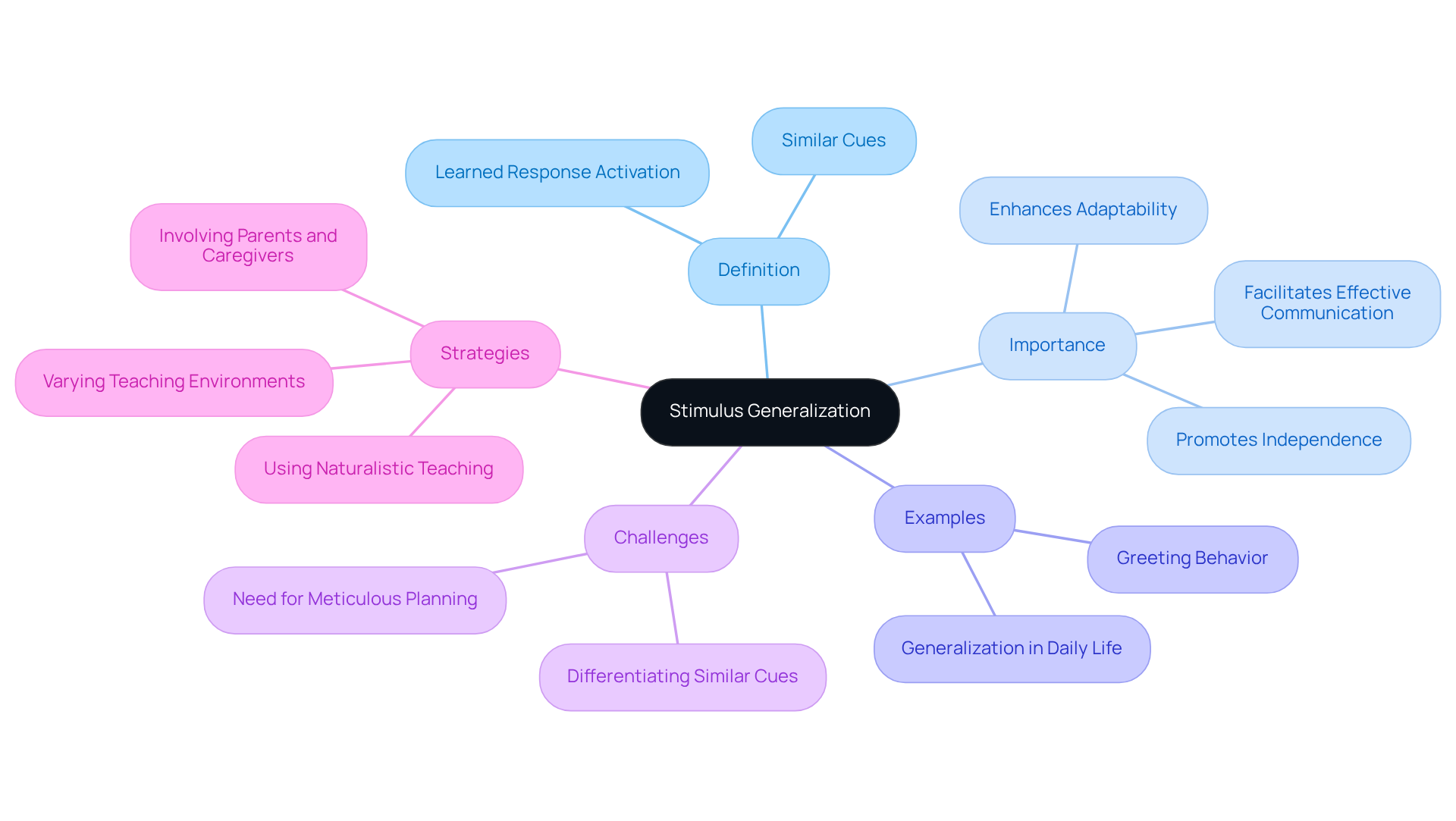
The concept of response broadening, rooted in classical conditioning, was first elucidated by Ivan Pavlov in the early 20th century. His groundbreaking experiments demonstrated that dogs could be conditioned to salivate at the sound of a bell, illustrating that such reactions extend to similar auditory signals. This pivotal research laid the foundation for understanding the application of knowledge in both animal and human behavior.
Over the years, the exploration of response broadening has significantly advanced, particularly within the realm of Applied Behavior Analysis (ABA) therapy. Experts assert that understanding how individuals generalize learned behaviors is essential for effective treatment planning.
For an example of stimulus generalization, case studies reveal that integrating varied stimuli during training can mitigate issues like stimulus overselectivity, where individuals concentrate on specific elements of their environment.
Furthermore, research indicates that the ability to transfer skills is fundamental to successful ABA therapy, enabling individuals to apply acquired skills across diverse situations, thereby enhancing their independence and quality of life.
As the field continues to evolve, ongoing research aims to refine measurement techniques and develop innovative models that assess real-world applications of extrapolation, ensuring that Pavlov's principles remain relevant in contemporary therapeutic practices.
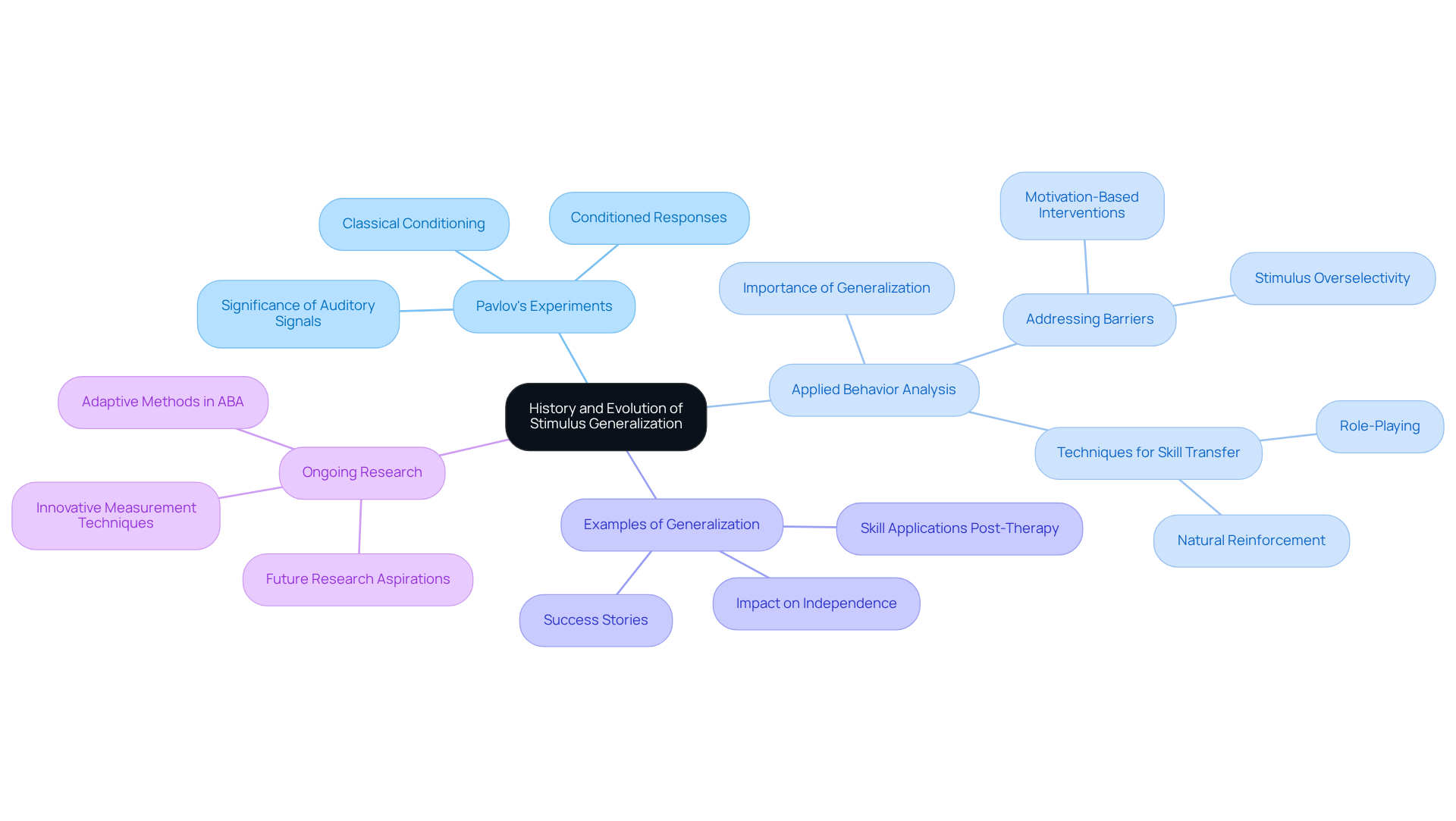
In everyday life, there are many real-world examples of stimulus generalization. Consider a young person who learns to identify a red ball during therapy; they may later recognize other red objects, such as apples or stop signs. Similarly, a child instructed to seek help in a therapy session may provide an example of stimulus generalization by asking for assistance at school or home. An individual who develops a fear of dogs after being bitten by one breed is an example of stimulus generalization, as they may subsequently exhibit fear towards all dogs, regardless of breed.
This phenomenon serves as an example of stimulus generalization, reminiscent of the Little Albert experiment, where a young child developed a fear of white rats after being conditioned with loud noises, illustrating how fear responses can generalize beyond the initial trigger. These examples underscore the importance of fostering adaptability in therapy to ensure that acquired skills transfer to various contexts, thereby enhancing the individual's quality of life.
It is also crucial to recognize that while the transfer of stimuli can facilitate learning, challenges remain, particularly in achieving response transfer with language in children with autism. For instance, rote and inflexible responding can impede the application of learned behaviors in new situations. Overall, effective transfer of learning can significantly enhance social interactions and everyday functioning, making it a vital priority for professionals.
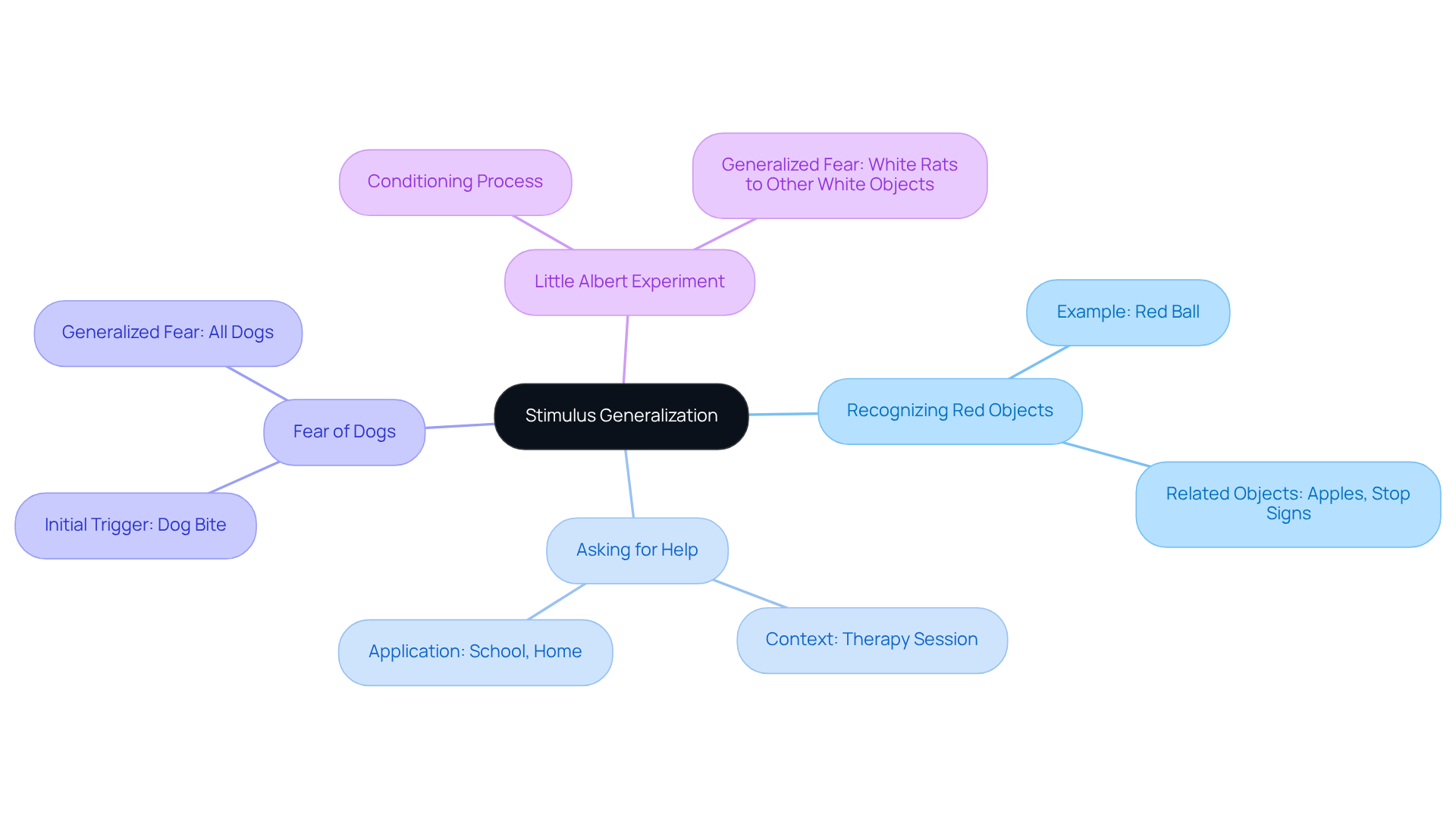
Understanding the example of stimulus generalization requires familiarity with several associated terms and concepts. One such concept is the discrimination of stimuli, which refers to the ability to distinguish between similar inputs and respond appropriately. For instance, a young individual may learn to greet their teacher with 'hello' while refraining from doing so with strangers, illustrating the process of discrimination.
Another pertinent term is response generalization, where a single trigger can elicit various reactions. For example, a child might learn to request a snack during therapy and later apply that skill to ask for a drink. Grasping these concepts is crucial for practitioners in Applied Behavior Analysis (ABA), as they inform strategies that promote effective learning and behavior modification.
Moreover, altering the significance of signals is vital for enhancing learning outcomes. By adjusting the intensity or clarity of inputs, practitioners can improve the efficacy of discrimination training. The concept of overselectivity further highlights the challenges learners face when they focus on irrelevant aspects of stimuli, potentially hindering their ability to discriminate effectively.
Error analyses are instrumental in pinpointing the sources of faulty stimulus control, enabling practitioners to refine their methodologies and enhance learning outcomes. For example, in a case study where a child was taught to differentiate between various food containers utilizing labels, the application of these concepts resulted in improved understanding and broader skill application across different contexts.
Experts in the field assert that clear signals regarding expected behaviors are essential for individuals with autism spectrum disorder (ASD). By systematically teaching discrimination and using an example of stimulus generalization, practitioners can cultivate more adaptive behaviors in their clients, ultimately enhancing their quality of life.
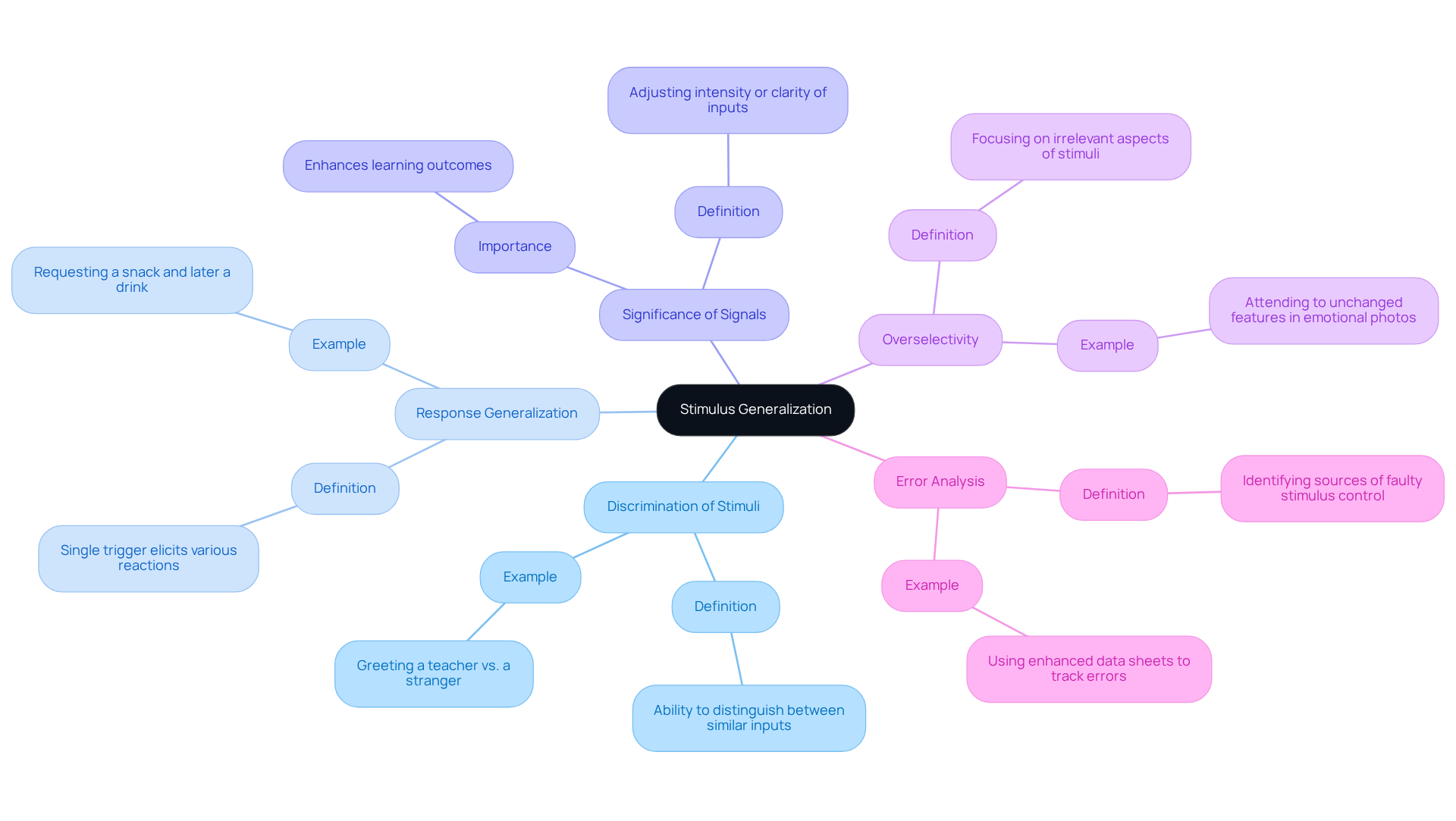
Understanding stimulus generalization is essential for enhancing the adaptability and effectiveness of behaviors learned in Applied Behavior Analysis (ABA) therapy. This concept not only facilitates the transfer of skills across various contexts but also plays a critical role in improving the quality of life for individuals, particularly those with autism. By recognizing and applying learned behaviors in diverse situations, individuals can develop greater autonomy and confidence in their daily interactions.
The historical roots and evolution of stimulus generalization highlight its significance in both theory and practice. Key examples illustrate how learned responses can extend beyond initial cues, such as:
Moreover, the importance of involving caregivers in the process and addressing challenges like stimulus overselectivity are emphasized, showcasing the complexities involved in achieving effective behavior transfer.
The insights presented underline the necessity of fostering adaptability in therapeutic settings. By implementing strategies that promote stimulus generalization, practitioners can empower individuals to navigate their environments more effectively. As the field of ABA therapy continues to evolve, ongoing research and application of these principles will be vital in ensuring that the skills learned during therapy translate into meaningful real-life outcomes. Embracing this approach enhances individual capabilities and enriches social interactions, ultimately leading to a more fulfilling life.
What is stimulus generalization?
Stimulus generalization is the process by which a learned response to a specific cue is triggered by similar cues, allowing individuals to apply learned behaviors across various contexts.
Why is stimulus generalization important in Applied Behavior Analysis (ABA)?
It enhances adaptability and practical abilities, enabling individuals to generalize learned skills in different situations, which is crucial for effective communication and social interaction.
Can you give an example of stimulus generalization?
An example is when a young person learns to say 'hello' to a known individual and then extends this greeting to unfamiliar people in similar situations, demonstrating stimulus transfer.
What challenges are associated with promoting stimulus generalization?
Encouraging broad application of learned behaviors can be challenging and requires meticulous planning and execution of approaches that facilitate the use of skills in diverse settings.
How do parents and caregivers contribute to stimulus generalization?
Involving parents and caregivers is essential as their support reinforces the skills learned during therapy and helps children practice these skills in everyday situations.
What is the significance of differentiating between comparable cues in stimulus generalization?
Understanding how to differentiate between similar cues is crucial for effective categorization, which aids in the appropriate application of learned behaviors.
What are the two primary types of generalization recognized in ABA therapy?
The two primary types of generalization are stimulus generalization and response generalization.
How does stimulus generalization benefit children with autism?
It empowers children with autism to utilize their abilities in practical situations, fostering autonomy and self-assurance in their daily lives, and ensuring that skills acquired during therapy are applied in various environments, such as home and school.
Our expert recruitment strategies and AI-driven sourcing ensure that you receive top-notch candidates quickly, without compromising on quality. Whether you’re looking for BCBAs, Clinical Directors, or RBTs, we’ve got you covered.